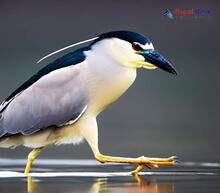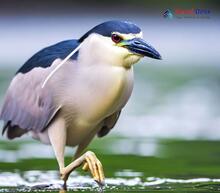Bird enthusiasts and nature lovers alike will be intrigued by the captivating world of the Nycticorax genus. With their exceptional nocturnal behavior and striking appearance, these fascinating birds hold a special place within the avian kingdom. Here, we'll explore the enthralling characteristics of the genus Nycticorax and examine what makes them stand out from other species.
Nycticorax: A Brief Overview
The Nycticorax genus belongs to the Ardeidae family, which consists of herons, egrets, and bitterns. The name "Nycticorax" itself is derived from the Greek words for "night" and "raven," aptly describing their nocturnal habits and distinctive call that shares similarities with a crow's caw. These medium-sized birds are known for their unique crepuscular and nocturnal activities, setting them apart from most other members of the Ardeidae family.
Physical Characteristics
Members of the Nycticorax genus have a striking appearance that commands attention. Sporting a predominantly grayish coloration, they possess a notable black cap and sometimes feature reddish-brown to chestnut hues on their wings or shoulders. The most distinguishing aspect is likely their vibrant red eyes—an adaptation primarily attributed to their night-time activities. With short necks and thick bills, these birds fit perfectly within marshy environments where they wade through shallow waters in search of prey.
Habitat & Distribution
These intriguing birds can be found across various habitats depending on the specific species. In general, they favor marshy areas, wetlands, swamps, or shallow coastlines where they can easily forage at dawn or dusk. They demonstrate impressive adaptability when it comes to their global distribution; species within this genus can be found inhabiting regions as diverse as North America, Eurasia, Africa, and Australia. Some are known to be migratory, while others are more sedentary and remain in their environment year-round.
Behavior & Diet
Nycticorax birds are skilled predators who make the most of their environment. Their diet primarily consists of fish, amphibians, and crustaceans found in shallow waters. These birds employ a "sit-and-wait" predatory style; they will perch motionless within their favored habitat before quickly striking their prey with impressive accuracy. The nocturnal habits of the genus Nycticorax have not only granted them a unique niche within their ecosystem but also provided them with fewer competitors during their prime hunting hours.
Conservation & Public Interest
Several species within the Nycticorax genus face threats from habitat loss, pollution, and human encroachment. As such, conservation efforts are crucial to maintaining healthy populations of these intriguing birds. Birdwatching enthusiasts who appreciate these enigmatic creatures are encouraged to partake in responsible birding practices and contribute to preserving these incredible species for future generations to enjoy.
In conclusion, the Nycticorax genus offers a unique blend of captivating features that set them apart from other avian species. Their striking appearance and nocturnal behavior provide insight into the diverse world of bird profiles and serve as a fascinating reminder of nature's endless capacity for wonder and intrigue.




